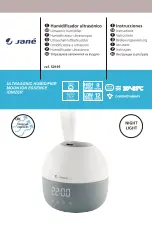
30
tional battery.
After moving the machine away from all the pack-
ing, start mounting the accessories and the batter-
ies as per the instructions provided in the specific
section.
Keep all the pieces of the packing since they might
be useful in the future to protect the machine and
the accessories during transport to another loca-
tion or to authorised service centres. If not, the
packing can be disposed in accordance with current
disposal laws.
4.4
UNBLOCKING THE ELECTROME-
CHANICAL BRAKE
When the machine is switched off or with-
out batteries the electromechanical brake is
blocking the machine and it is not possible to
move it.
To unblock the electromechanical brake it is nec-
essary to operate on the traction motor placed on
the rear wheel axle (Photo L) following the proce-
dure mentioned here below:
- Pull the unblocking lever (Photo L - 1) outwards
- Rotate the lever downwards and block the lever
on the pin placed on the motor in order that the
lever will be fixed in the outer position (Photo L - 2).
The mechanical brake is now unlocked and it
is now possible to move the machine.
Once the machine have been moved, it is neces-
sary to carry out the same procedure on the con-
trary in order to replace the lever in the machine
working position ( Photo L - 1 ).
WARNING: Before using the machine be
sure that the unblocking lever is in the ma-
chine working position ( Photo L - 1 ).
4.5
LIFTING AND TRANSPORT: MACHI-
NE, BATTERY AND BATTERY CHARGER
Never use a forklift truck to lift the machine.
There are no places on the frame that can be used
to lift the machine directly.
Before preparing the packing and transporting the
machine:
- Empty the recovery tank and the detergent solu-
tion tank.
- Disassemble the squeegee and the brushes or
pad drivers.
- Disconnect and remove the batteries.
Place the machine on the original pallet (or an
equivalent one that can bear the weight and is big
enough for the machine’s overall dimensions) using
an inclined surface.
Solidly anchor the machine and the squeegee to
the pallet using metallic brackets or other elements
that can bear the weight of the parts.
Lift the pallet with the machine and load it on the
transport vehicle.
Secure the machine and the pallet using ropes con-
nected to the transport vehicle.
As an alternative, when using private transport
vehicles, use inclined ramps to push the machine
without the pallet, making sure to protect all parts
and the machine itself against violent impacts, hu-
midity, vibrations and accidental movements during
transport.
The battery boxes have holes where tools can be
hooked for handling.
To lift or insert the battery (into the machine
compartment), use only suitable personnel and
equipment (cables, eyehooks, etc.) for the opera-
tion and to bear the weight of the loads involved.
When transporting, take the same precautions and
follow the same instructions provided for the ma-
chine together with those in the special manufac-
turer’s manual.
The battery charger can be transported on its sup-
ports, both vertically and horizontally. Take the
same precautions and follow the same instructions
provided for the machine together with those in the
special manufacturer’s manual.
5. TECHNICAL INFORMATIONS
5.1 GENERAL
DESCRIPTION
5.1.1 BATTERIES
Regardless of the type of construction, battery
performances are indicated with the term capac-
ity, which always refers to a discharge period. An-
other important value is the number of possible
discharges. The capacity is expressed in amps per
hour (Ah), while the discharge period is generally
indicated as 20 hours (C20 or 20h, or not expressly
indicated) or 5 hours (C5 or 5h). The discharge/
charge cycles indicate the number of times that
the battery can hold a charge under the best con-
ditions, i.e. they indicate the useful battery service
life complying with all the necessary measures.
Therefore, the capacity of a battery varies depend-
ing on how fast it uses energy (current). That’s why
there’s such a variation in the capacity values ex-
pressed as C5 or C20. These factors must be taken
into account when comparing products available on
the market with our own.
This machine can be equipped with two types of
batteries that differ in terms of their construction
and features.
- Pb-Acid battery with tubular armoured modules:
the electrolyte level in each element must be peri-
odically checked!
If one element is no longer covered by the acid
solution it will oxidise in 24 hours, thus perma-
nently affecting that element’s performance.
☞
Refer to the battery manual to avoid physical
damage and economic loss.
- Gel module battery: this type of battery is main-
tenance free and does not require special envi-
ronments for recharging (since it does not emit
Summary of Contents for KF 675BBC
Page 2: ......
Page 3: ...2 ESPA OL ES PAGINA 10 ENGLISH EN PAGE 26 FOTOGRAFIAS PHOTOGRAPHS PAGINA PAGE 3...
Page 4: ...3 1 2 A B 1 5 4 2 7 4 5 6 9 8 3 3...
Page 5: ...4 C 1 1 D 3 4 2...
Page 6: ...5 3 3 2 1 4 6 7 6 7 1 2 5 E F 1...
Page 7: ...6 H 2 G 1 3 3 1 4 2...
Page 9: ...8 1 L 2 2 4 1 M 3...
Page 10: ...9 N O 1 2 2 3 6 7 5 4 0 8 1 7 2 2 2 9 4 3 0 4 H2O CHEM 1 2 1 1 1 0 1 3 1 7 2 5 1...
Page 44: ......
















































